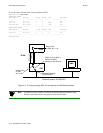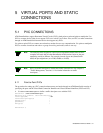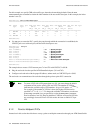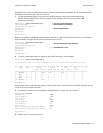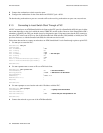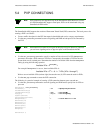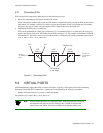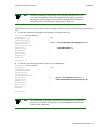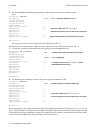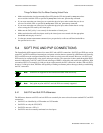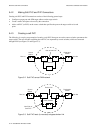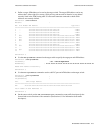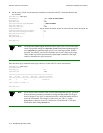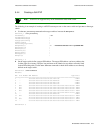
5-8 SmartSwitch ATM User Guide
Virtual Ports Virtual Ports and Static Connections
5.3.1 Creating Virtual Ports
Virtual ports are created on physical ports by first allocating a range of Virtual Path Identifiers (VPIs), and then
distributing the VPIs among the virtual ports. The number of VPIs used depends on the number of virtual ports needed
and the range of VPIs controlled by each virtual port.
When creating virtual ports, it’s important to remember that the virtual port number represents the Base VPI used by
the virtual port. For example, the virtual port
5b1.3 uses Base VPI = 3.
Creating virtual ports on an ATM SmartSwitch consists of the following basic process
• Create a traffic descriptor for the virtual port that meets its bandwidth and service category
requirements.
Note To assure that virtual ports receives the exact bandwidth required, you may want
to assign them traffic descriptors that specify CBR as the service class.
• Use the set portconfig command to turn off signaling on the physical port on which you are
creating the virtual ports.
Note Signaling is usually not used on physical ports on which virtual ports are created.
However, you can leave signaling active on the physical ports if necessary.
• Use the MaxVpiBits parameters of the set portconfig command to set the number of bits to use
for VPIs for virtual ports on this physical port:
Available VPIs = 2
MaxVpiBits
- 1
For example, if
MaxVpiBits is set to 3, then the number of VPIs available for virtual ports is:
Available VPIs = 2
3
- 1 = 8 - 1 = 7
Note The value for
Available VPIs
is also the highest number that can be used to
specify a virtual port on the physical port. For instance, in the example above,
7a1.7 is the highest virtual port that can be created using MaxVpiBits = 3.
• Use the add port command to create the virtual port and to specify the number of VPIs used by the
virtual port. Note that the
add port command also uses the MaxVpiBits parameter, however, here
it’s used to define the number of VPIs the virtual port uses, based on the equation:
VPIs Used by Virtual Port = Base VPI + (2
MaxVpiBits
-1)
For example, if the virtual port number is
5b2.1 (Base VPI = 1), and MaxVpiBits = 1, then the total number of VPIs
used by this virtual port is:
Base VPI + (2
1
-1) = 1 + (2-1) = 1 + 1 = 2 VPIs
So port
5b2.1 controls VPI 1 (the Base VPI) and VPI 2.



